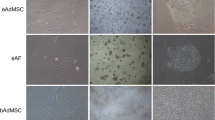Abstract
Nanog is a homeodomain containing protein which plays important roles in regulation of signaling pathways for maintenance and induction of pluripotency in stem cells. Because of its unique expression in stem cells it is also regarded as pluripotency marker. In this study goat Nanog (gNanog) gene has been amplified, cloned and characterized at sequence level with successful over-expression in CHO-K1 cell line using a lentiviral based system. gNanog ORF is 903 bp long which codes for Nanog protein of size 300 amino acids (aas). Complete nucleotide sequence shows some evolutionary mutation in goat in comparision to other species. Protein sequence of goat is highly similar to other species. Overall, gNanog nucleotide sequence and predicted protein sequence showed high similarity and minimum divergence with cattle (96 % identity/4 % divergence) and buffalo (94/5 %) while low similarity and high divergence with pig (84/15 %), human (81/23 %) and mouse (69/40 %) indicating evolutionary closeness of gNanog to cattle and buffalo. gNanog lentiviral expression construct was prepared for over-expression of Nanog gene in adult goat fibroblast cells. Lentiviral expression construct of Nanog enabled continuous protein expression for induction and maintenance of pluripotency. Western blotting revealed the expression of Nanog gene at protein level which supported that the lentiviral expression system is highly promising for Nanog protein expression in differentiated goat cell.




Similar content being viewed by others
References
Boyer LA, Lee TI, Cole MF, Johnstone SE, Levine SS, Zucker JP, Guenther MG, Kumar RM, Murray HL, Jenner RG, Gifford DK, Melton DA, Jaenisch R, Young RA (2005) Core transcriptional regulatory circuitry in human embryonic stem cells. Cell 122:947–956
Cole MF, Johnstone SE, Newman JJ, Kagey MH, Young RA (2008) Tcf3 is an integral component of the core regulatory circuitry of embryonic stem cells. Genes Dev 22:746–755
Loh YH, Wu Q, Chew JL, Vega VB, Zhang W, Chen X, Bourque G, George J, Leong B, Liu J, Wong KY, Sung KW, Lee CW, Zhao XD, Chiu KP, Lipovich L, Kuznetsov VA, Robson P, Stanton LW, Wei CL, Ruan Y, Lim B, Ng HH (2006) The Oct4 and Nanog transcription network regulates pluripotency in mouse embryonic stem cells. Nat Genet 38:431–440
Wang J, Rao S, Chu J, Shen X, Levasseur DN, Theunissen TW, Orkin SH (2006) A protein interaction network for pluripotency of embryonic stem cells. Nature 444:364–368
Mitsui K, Tokuzawa Y, Itoh H, Segawa K, Murakami M, Takahashi K, Maruyama M, Maeda M, Yamanaka S (2003) The homeoprotein Nanog is required for maintenance of pluripotency in mouse epiblast and ES cells. Cell 113:631–642
Chambers I, Silva J, Colby D, Nichols J, Nijmeijer B, Robertson M, Vrana J, Jones K, Grotewold L, Smith A (2007) Nanog safeguards pluripotency and mediates germline development. Nature 450:1230–1234
Lavial F, Acloque H, Bertocchini F, MacLeod D, Boast S, Bachelard E, Montillet G, Thenot S, Sang HM, Stem CD, Samarut J, Pain B (2007) The Oct4 homologue PouV and Nanog regulate pluripotency in chicken embryonic stem cells. Development 134:3549–3563
Yamaguchi Y, Ogura S, Ishida M, Karasawa M, Takada S (2005) Gene trap screening as an effective approach for identifcation of Wnt-responsive genes in the mouse embryo. Dev Dyn 233:484–495
Chambers I, Colby D, Robertson M, Nichols J, Lee S, Tweedie S, Smith A (2003) Functional expression cloning of Nanog, a pluripotency sustaining factor in embryonic stem cells. Cell 113:643–655
Maherali N, Sridharan R, Xie W, Utikal J, Eminli S, Arnold K, Stadtfeld M, Yachechko R, Tchieu J, Jaenisch R (2007) Directly reprogrammed fibroblasts show global epigenetic remodeling and widespread tissue contribution. Cell Stem Cell 1:55–70
Okita K, Ichisaka T, Yamanaka S (2007) Generation of germline competent induced pluripotent stem cells. Nature 448:313–317
Wernig M, Meissner A, Foreman R, Brambrink T, Ku M, Hochedlinger K, Bernstein BE, Jaenisch R (2007) In vitro reprogramming of fibroblasts into a pluripotent ES-cell-like state. Nature 448:318–324
Silva J, Chambers I, Pollard S, Smith A (2006) Nanog promotes transfer of pluripotency after cell fusion. Nature 441:997–1001
Silva J, Jennifer N, Theunissen TW, Guo G, van Oosten AL, Barrandon O, Wray W, Yamanaka S, Chambers I, Smith A (2009) Nanog is the gateway to the pluripotent ground state. Cell 138:722–737
Yu J, Vodyanik MA, Smuga-Otto K, Antosiewicz-Bourget J, Frane JL, Tian S, Nie J, Jonsdottir GA, Ruotti V, Stewart R (2007) Induced pluripotent stem cell lines derived from human somatic cells. Science 318:1917–1920
Ren J, Pak Y, He L, Qian L, Gu Y, Li H, Rao L, Liao J, Cui C, Xu X, Zhou J, Ri H, Xiao L (2011) Generation of hircine-induced pluripotent stem cells by somatic cell reprogramming. Cell Res 21:849–853
Garg S, Dutta R, Malakar D, Jena MK, Kumar D, Sahu S, Prakash B (2012) Cardiomyocytes rhythmically beating generated from goat embryonic stem cell. Theriogenology 77:829–839
Takahashi K, Tanabe K, Ohnuki M, Narita M, Ichisaka T, Tomoda K, Yamanaka S (2007) Induction of pluripotent stem cells from adult human fibroblasts by defined factors. Cell 131:861–872
Takahashi K, Yamanaka S (2006) Induction of pluripotent stem cells from mouse embryonic and adult fibroblast cultures by defined factors. Cell 126:663–676
Okita K, Nakagawa M, Hyenjong H, Ichisaka T, Yamanaka S (2008) Generation of mouse induced pluripotent stem cells without viral vectors. Science 322:949–953
Acknowledgments
University Grant Commission, Government of India has provided the Senior Research Fellowship to Dinesh K. Singhal, and Department of Biotechnology, Government of India has granted the fund for smooth running of this research work.
Author information
Authors and Affiliations
Corresponding author
Electronic supplementary material
Below is the link to the electronic supplementary material.
Rights and permissions
About this article
Cite this article
Singhal, D.K., Singhal, R., Malik, H.N. et al. Molecular cloning, sequence characterization and recombinant expression of Nanog gene in goat fibroblast cells using lentiviral based expression system. Mol Biol Rep 41, 1907–1915 (2014). https://doi.org/10.1007/s11033-013-2931-6
Received:
Accepted:
Published:
Issue Date:
DOI: https://doi.org/10.1007/s11033-013-2931-6




